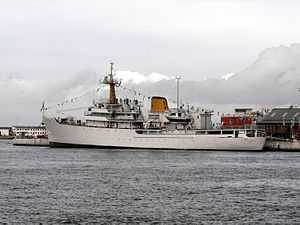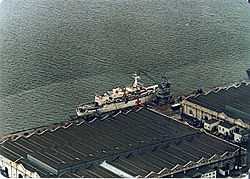Hecla-class survey vessel
 SAS Protea at Cape Town in 2011 | |
| Class overview | |
|---|---|
| Operators: |
|
| Cost: | £1.25 million |
| In commission: | UK: 1966-2001; South Africa: 1972-present |
| Completed: | 5 |
| Active: | 1 |
| Retired: | 4 |
| General characteristics | |
| Type: | Deep ocean hydrographic survey vessel |
| Displacement: | 2,800 tons (originally 2,733 tons) |
| Length: | 260 ft (79 m) |
| Beam: | 50 ft (15 m) |
| Draught: | 16 ft (4.9 m) |
| Propulsion: | 3 × Paxman Ventura 12YJCZ 12-cylinder turbo-charged diesel-electric engines for the 2,000 shaft horsepower main propulsion 2 × Paxman 6YJXZ auxiliary engines |
| Speed: | 14 knots (26 km/h) |
| Range: | 12,000 nautical miles (22,000 km) |
| Boats and landing craft carried: | 2 × 31 ft (9.4 m) surveying motor boats (SMB) 1 × 18 ft (5.5 m) SMB |
| Complement: | Generally a Commander (X)(H) in command (though sometimes a Captain RN), with 12-15 officers and 104-106 ratings, 1 NAAFI canteen manager, 1 laundryman |
| Aircraft carried: | 1 × Westland Wasp helicopter from 829 Naval Air Squadron |
| Aviation facilities: | Hangar, aft Flight deck recognition letters were HD (Hydra), HE (Herald), HL (Hecla), HT (Hecate) |
| Notes: | 1 × Land Rover (with garage, forward) |
The Hecla class formed the backbone of the Royal Navy's ocean survey fleet from the mid-1960s. Three ships, HMS Hecla, HMS Hecate and HMS Hydra, were ordered in the early 1960s to replace the aging survey ships HMS Scott and HMS Shackleton.
The hull design was based on that of the RRS Discovery and the Hecla class were built to commercial standards costing £1.25 million each. They carried two small survey craft, a launch, a Land Rover and a Wasp helicopter, for which there was a flight deck and hangar. A fourth ship, HMS Herald was ordered in the early 1970s. Three, all bar HMS Hecate, saw service as hospital ships in the Falklands War, while Herald also served in the Gulf War and as a temporary Antarctic Patrol Ship in 1991 and 1992. Hecate saw service as the temporary Antarctic Patrol Ship in 1982 after being painted grey and fitted with AA guns in Gibraltar. Hecate was the first Royal Navy vessel to visit South America following the Falklands conflict.
Hydra was sold to Indonesia in 1986 and renamed Dewa Kembar; Hecate decommissioned in 1990 and was broken up, while Hecla paid off in 1997 and was sold to an Irish private company, to be replaced by HMS Scott. Herald was finally decommissioned in 2001, and was replaced the same year by HMS Echo.
A fifth Hecla-class vessel, SAS Protea (A324) was ordered by the South African Navy and commissioned on 23 May 1972. As of 2013, Protea remains in service.[1]
Gallery
-

HMS Hecla being converted to an ambulance ship in HM Naval Base Gibraltar.
Special modifications
Besides the strengthened hull for work in ice and the provision of air conditioning necessary for work in all climates, they had modifications particular for a scientific vessel: wet and dry laboratories; a survey chartroom and photographic darkroom; oceanographic winches for deep seawater analysis and coring; stabilisers and a bow thruster, which enabled the ship to maintain her position when stopped for scientific observations.
See also
References
- ↑ "Fact file: Hecla (Protea)-class hydrographic vessel". DefenceWeb.za. Retrieved 2013-12-06.